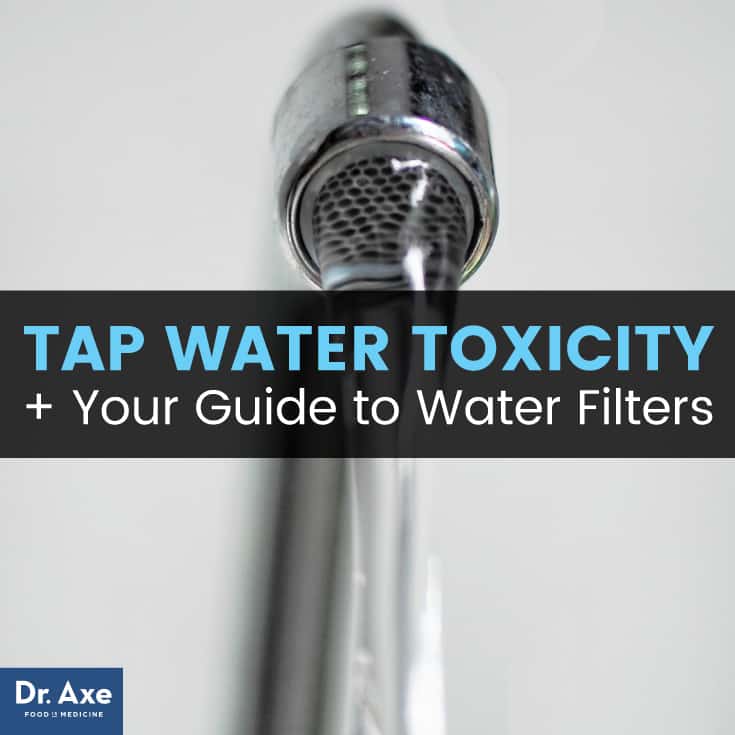
Most of us don’t think too much about what’s in our water, despite the fact that we know that drinking water is key to our health. If it’s the public water supply, then it’s regulated, right? And even if we don’t have the best tap water, there’s always the bottled option.
But as the water crisis in Flint, Mich., has proven, the water we’re being supplied isn’t always good for us. In fact, it can be downright dangerous to our health, and it can take years to turn things around. Of course, the regulations in place are also affected by industrial, military and pharmaceutical lobbies as well.
And bottled water isn’t necessarily a better option. Aside from the fact that these plastic bottles are terrible for the environment, bottled water isn’t well regulated either.
That’s why it’s important to know what is actually coming out of your kitchen faucet, and how tap water toxicity might be affecting you and your family.
Tap Water Toxicity
Tap water toxicity is the presence of toxins in our water supply — things like dangerous chemicals, compounds and metals. In fact, in 2009, a three-year study conducted by the Environmental Working Group found 316 chemicals in tap water throughout the country. (1, 2) Of these, 202 of the chemicals weren’t regulated, while others don’t pass guideline levels.
Guidelines are tricky, too. For instance, water utility companies who serve only a few thousand customers aren’t obligated to treat water to prevent lead contamination until after lead is discovered. A ground-breaking report from USA Today found that about 4 million Americans receive their water supply from these small utility companies annually. (3) Many of them miss the annual testing for harmful chemicals, meaning water goes for another 365 days — at least — without anyone knowing whether tap water toxicity is an issue or not.
Bigger cities aren’t immune, though. As our nation’s infrastructure and pipes that are contaminated with things like bacteria, copper and lead aren’t replaced, it’s likely that we’ll see more Flint-like cases around the country.
In fact, the American Society of Civil Engineers gave the country a “D” on its 2017 Drinking Water Infrastructure Report Card. (4) Among the reasons cited were the fact that, at the rate that utility companies are replacing outdated pipes (0.5 percent a year), it would take nearly 200 years to replace our aging system, well beyond the 50–75 years they’re built to withstand. They also pointed to the lack of funding and investment in the quality of American drinking water and its infrastructure.
So, What’s In Your Tap Water?
So what exactly are the toxins that you might find in your water supply?
Atrazine is a major one. It’s the second-most widely used herbicide in the country. But it doesn’t stick to just crops; atrazine winds up in our ground and surface water, where it later winds up in our water supply, and often at levels much higher than what’s considered safe.
Atrazine is known as an endocrine disruptor, or a chemical that after enough exposure, messes with our hormonal systems. Having just one hormone out of whack can cause serious developmental, neurological, reproductive and immune effects. The chemical has been linked to birth defects during pregnancy and raised levels of estrogen in women, which can increase the risk of both breast and ovarian cancers. It’s also been found to feminize frogs, turning once-male frogs into females.
Lead is a heavy metal that leaches through lead pipes and corroded infrastructure. It is toxic to almost every major organ in the body and acts as a poison in the body. What’s scary is that it’s absorbed by the bloodstream, affecting different parts of the body as it reaches them. (5) It’s especially dangerous for children, because their bodies are more susceptible to both absorbing and retaining the metal.
Arsenic is another chemical that’s found in our tap water. In 2001, the EPA finally lowered the drinking water standard from 50 ppb to 10 ppb. Sadly, the agency had advocated for the limit to be 5 ppb, but water companies argued it would too expensive to implement. (6) Arsenic has been linked to cancers of the prostate, liver, kidneys, lungs, skin and nasal passages, among others. (7) While arsenic levels have decreased since the EPA’s standards changed, it’s still a concern in tap water.
Why Bottled Water Isn’t Always a Better Option
If tap water has so many issues, shouldn’t bottled water be the better option? Not so fast. Just like tap water, bottled water comes with risks, too.
For starters, per gallon, bottled water costs about 2000 times more than tap water. (8) Worse, there’s not even a guarantee that you’re getting anything better than what’s coming out of your faucet.
Bottled water manufacturers aren’t required to disclose the level of contaminants in their water, and in many cases, it’s simply tap water anyway. While the EPA oversees what comes out of the tap, it’s the Food and Drug Administration that’s responsible for bottled water. That usually means ensuring that what’s advertised on the label is what’s actually being sold. It’s up to states to regulate the actual water, though sometimes not even that happens.
And you might be paying more money for no reason. The National Resources Defense Council estimates that at least 25 percent of bottled water is really just tap water and 22 percent of the brands they tested contained contaminant levels above state health limits. (9)
Another reason to be wary of bottled water is the amount of chemicals that leach from the plastic bottles. Bisphenol A is one of them. BPAs, as they’re known, are found in plastics, including water bottles. They can be transmitted from the bottle to the water, even if the water wasn’t originally tainted with BPAs. These chemicals are another endocrine disruptor. In this case, they mimic estrogen, interfering with all hormone levels and genetic messages.
BPAs are linked to reproductive health problems and breast, ovarian and prostate cancers. Diabetes and liver toxicity might also be linked to the chemical.
So when does bottled water make sense? If you’re traveling somewhere with bad water quality or are on the go and the only other option is soda and another unhealthy drink then, by all means, grab a bottle of water.
But be sure to check the label before drinking. If it says the water comes from a “municipal source,” “P.W.S.” (public water source) or from a “community water system,” it’s just plain ole tap water. Skip “purified water” or “drinking water,” too, and look for spring water.
Guide to Water Filters
If tap water can’t always be trusted and bottled water is often just really expensive tap water, what’s the safest option?
Using an at-home filter is your best bet. This will remove toxins that might be lingering in the water supply without the exorbitant price of purchasing bottled water. There are six different kinds of water filters and eight different filtering methods.
There are several different types of water filters: a pitcher, a faucet-mount, a faucet-integration, a counter-top filter, an under-sink filter or a whole-house water filter. You should choose the option that works best with your family’s lifestyle and that will be easiest to use consistently.
There are also a variety of filtering methods to choose from, including carbon-activated, ceramic, ion exchange, mechanical filters, ozone, reverse osmosis, UV light and water softeners. Check out the differences in filtering methods below:
Carbon/Activated Carbon Filters: Activated carbon binds with many contaminants and removes them from water. It can remove asbestos, chlorine, lead, mercury and volatile organic compounds (VOCs). But carbon filters cannot remove arsenic, fluoride, nitrate or percholate. Their effectiveness varies widely by manufacturer — some may only remove chlorine.
Ceramic Filters: Ceramic filters work like spaghetti strainers, blocking sediment and large particles. They do not remove chemicals.
Deionization/ Ion Exchange Filters: An ion exchange filter can remove heavy metals, minerals and charged ions. It cannot remove chlorine byproducts, microorganisms or volatile organic chemicals (VOCs).
Mechanical Filters: These strainers can remove large particles from water but do not remove chemicals.
Ozone Filters: Ozone can kill bacteria and microorganisms, but does not remove chemicals.
Reverse Osmosis: Reverse osmosis filters use a semi-permeable membrane that can trap any molecule bigger than water. They are more effective than carbon filters since they are able to remove fluoride. A reverse osmosis filter is my personal recommendation for the kind of water filter that is best.
UV Light: Ultraviolet light kills bacteria and microorganisms but does not remove chemicals.
Water Softeners: These ion exchange filters remove barium, calcium, magnesium and radium. They do not remove other contaminants. They also add sodium to the water.
Tap water toxicity is pretty scary. We don’t want to imagine that something we rely on so heavily has the potential to adversely affect our health. Unfortunately, our system has a way to go until we can confidently drink tap water without fear of toxicity. Until then, using a filter is your best bet.







